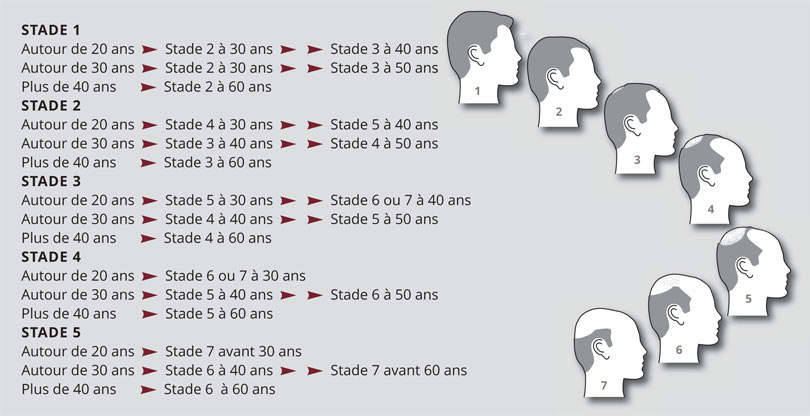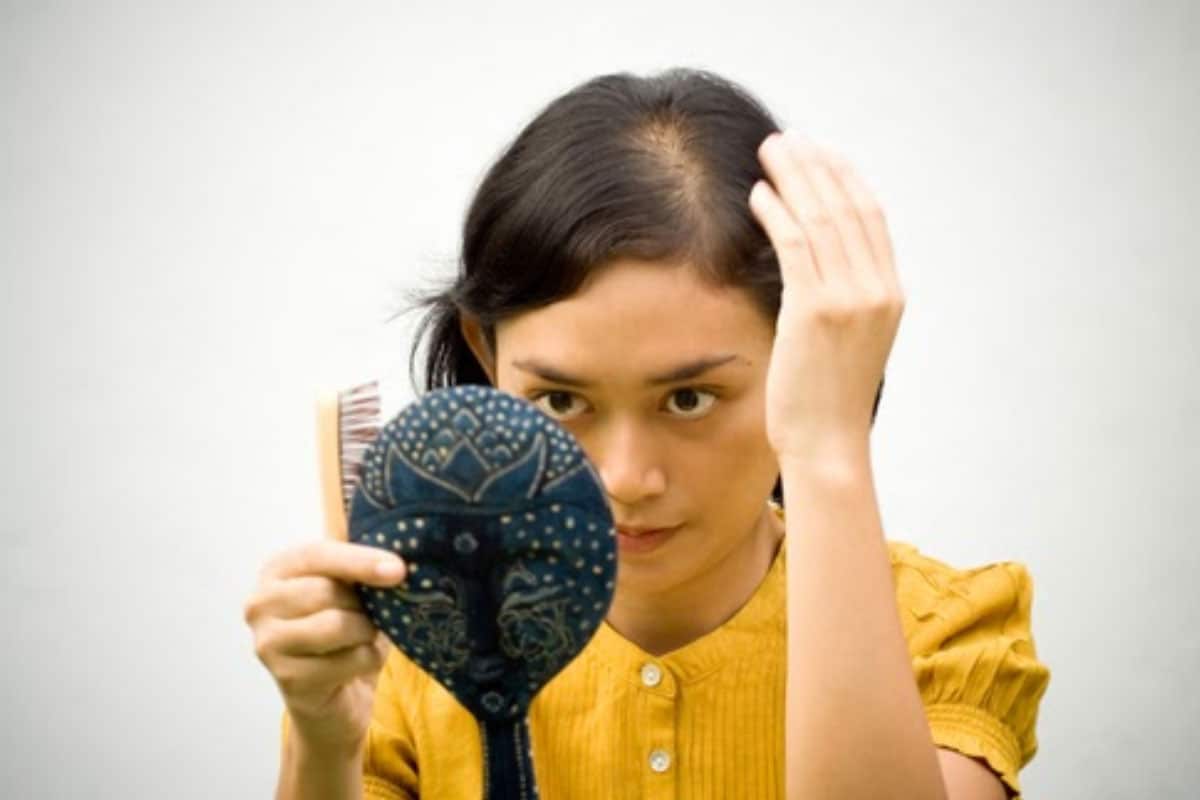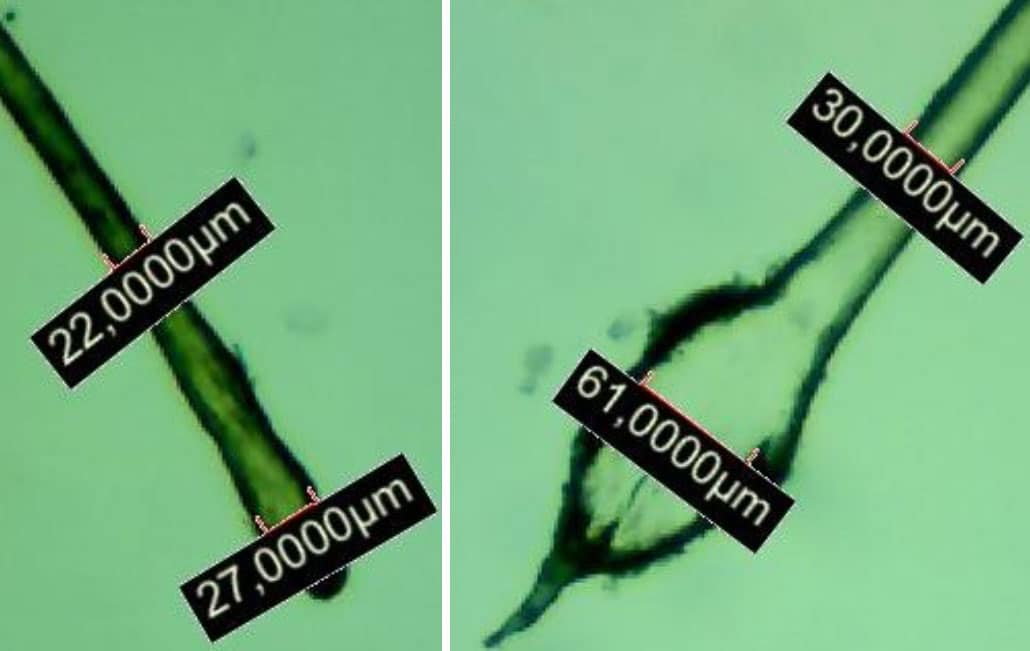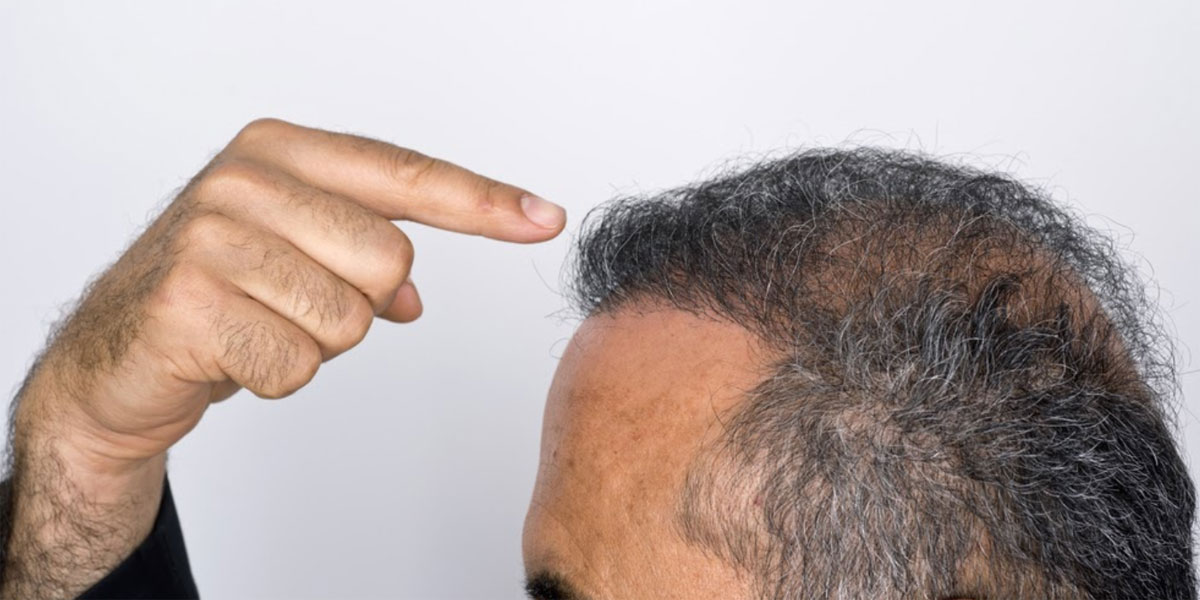Alopecia is the medical term used to describe the condition hair loss. It affects both men and women (Female alopecia), sometimes in different ways. There are many causes and many treatments. What results can we expect?
Description of alopecia
Hair loss can occur for no apparent reason, or be linked to an illness, a deficiency or the use of certain medications. The symptoms of alopecia vary depending on the cause. They range from the appearance of a small area without hair to complete loss of all body hair.
The different types of alopecia
Male alopecia
This is the most common form of alopecia. This type of alopecia generally begins in men around the age of 30. In its most severe forms, it can start earlier, at the end of puberty. It affects around 70% of men in their fifties.
Also known as androgenetic alopecia, this form of baldness is considered hereditary. But, as we shall see later, there are solutions.
Male alopecia is associated with excessive sensitivity of the hair follicles to the activity of male hormones. In male pattern baldness, the hair roots gradually weaken. Male alopecia is associated with excessive sensitivity of the hair follicles to the activity of male hormones. Specifically, male hormones are transformed in the hair follicle into dihydrotestosterone (DHT). DHT disrupts the hair's life cycle, causing premature ageing of the hair and, as a result, accelerated thinning and loss of elasticity. hair loss in men.
The first signs of male alopecia can be seen on the temporal gulfs, which become increasingly bald in a line resembling the letter "M". Hair becomes thinner and less numerous on the vertex (top of the head) and then on the top of the head.
The Hamilton scale describes the predictable course of androgenetic alopecia in men.

In women

La Hair loss also affects women. Some specialists in the scientific community believe that this type of baldness is hereditary (as in humans), while others do not.
As in humans, it is the result of increased sensitivity on the part of the hair follicles to the activity of male hormones. Unlike male alopecia, it does not generally manifest itself as a receding hairline on the forehead, but as a general thinning of the hair on the crown of the head. It most often occurs (as we have observed) following a hormonal change such as a pregnancy, taking a contraceptive pill or menopause.
Alopecia areata
Also known as uneven baldness or alopecia areata, it occurs suddenly and recurrence can be frequent. Men, women and children of any age can be affected, although it is more common in teenagers and young adults. It can affect any part of the body, although hairless patches most often appear on the scalp.
According to the most recent studies, it is caused by (https://apropeau.ca/l-alopecie), by an immune system disorder, where the immune system comes to regard the hair as an enemy. People with autoimmune diseases are more likely to be affected.
Traction alopecia
This form of alopecia affects the edges of the hair and results from hairstyles that tend to pull too much on the hair, ultimately pulling it out over time. The life cycle of the hair is shortened and the hair becomes thinner.
Traction alopecia most often affects Afro-type hair (braids from the first millimetres of hair growth) but also certain young girls whose ponytail or chignon is too tight.
Scarring alopecia
This type of alopecia refers to permanent hair loss caused by rare diseases such as scleroderma and discoid lupus. The hair follicles are completely destroyed and the hair no longer grows back. This rare form of alopecia affects both men and women and is more common in adults than in children.
The anagen effluvium
It is a form of hair loss that can affect the entire body, scalp and face. Anagen effluvium is most often caused by products used to treat cancer by chemotherapy and, in some cases, other anti-cancer therapies such as radiotherapy or immunotherapy.
Hair loss generally begins after a few weeks of treatment. It should be noted, however, that not all products used in the fight against cancer have this effect. Alopecia is generally temporary, and hair begins to grow back about six months after treatment has stopped.
Telogen effluvium
The characteristics of telogen effluvium are hair that falls out more than usual and refined.
Telogen effluvium generally affects the entire skull, with other parts of the body unaffected. This alopecia is sometimes reversible, with the hair starting to grow again around 6 months after the first symptoms appear. In most cases, however, it is permanent, the hair loses density and continues to thin. Although its causes are still poorly understood, this type of alopecia often appears following extreme emotional or physical stress or a serious infection.
What treatments are available to combat alopecia?
There is no known treatment for alopecia of the peladic type, scarring alopecia or anagen effluvium. The pharmaceutical industry has developed two molecules to treat male or female alopecia or traction alopecia:
Minoxidil
Minoxidil at 2% was marketed with a marketing authorisation (i.e. on prescription) in 1983. A concentrated version at 5% was launched in 2005. Until 2012, minoxidil was only available on prescription. It was originally developed to treat cardiovascular problems. During clinical trials, it was observed that a side effect was an increase in hair growth all over the body. Hence the idea of pharmaceutical laboratories to apply it directly to the scalp. However, the mechanisms by which minoxidil affects hair growth are not known.
Finasteride
Finasteride (intended exclusively for men) has been marketed since 1999. Finasteride has been the subject of regular warnings from the French Health Authority (ANSM) because of its effects on health, particularly the side effects of sexual dysfunction and psychiatric disorders. These two families of side effects may persist even after the drug has been taken. The ANSM concludes (Finasteride: reminder of the risks of psychiatric and sexual function disorders - Information point, February 2019, ANSM).
What do I need to know about treatments for alopecia?
- they are not effective in all cases,
- they do not produce spectacular results,
- They have a number of side effects, including dizziness, headaches, irritation and itching, etc.
- If you stop taking them, you will experience an increase in hair loss.
Medicine considers male and female alopecia to be a natural consequence of ageing. As they are not harmful to health, they do not necessarily require special treatment.
The Centre Clauderer's solution for treating alopecia
Developed from of natural active ingredients The Clauderer solution is the fruit of scientific research. With no side effects, treatment at the Centre Clauderer guarantees long-lasting results, even after you have completed your treatment.
The active ingredients used in Clauderer treatments have been shown in vitro to be far more effective than Minoxidil 5 % in combating hair loss. According to Dr Stéphanie Morot, who conducted the study: "The inhibitory action of Clauderer serum is faster and stronger on the hormone dihydrotestosterone than minoxidil at 5 % when used daily in vitro on human follicular keratinocytes".
By developing a precise treatment protocol, the Centre Clauderer offers you a solution with proven effectiveness. After the first 4 months of treatment (representative sample of new customers in 2018),
- the average increase in root size was +72.83 %
- hair thickening (keratin) increased by +35.58 %

Diagnosis on 23 May 2018 (photos on the left) and check after 4 months (photos on the right): the root has increased from 27 µm to 61 µm and the keratin calibre has increased from 22 µm to 30 µm, an increase of 125.92 % and 36.36 % respectively.
Your questions about alopecia
Is alopecia inevitable?
Alopecia is inevitable insofar as it is usually programmed into our genes, but it is not inevitable. Depending on our genetic make-up, our hair follicles and hair roots develop a greater or lesser sensitivity to the activity of male hormones. In other words, we are born with a greater or lesser number of receptors: the more receptors we have in the hair follicle, the more likely we are to develop alopecia. However, there are ways of protecting our hair follicles, including those put in place by the Centre Clauderer.
Why is alopecia affecting more and more women?
This seems to be true, but science is unable to explain it. According to Canadian Dermatology Association 40 % of Caucasian women would show signs of hair loss at the age of 50, ranging from simple thinning to very marked balding of the entire head. Without comparison with an earlier period, it is impossible to draw any relevant conclusions. The stress of modern life, an industrial diet low in essential nutrients and certain contraceptives, not to mention the ageing of the population, are all cited as negative factors to explain this phenomenon.
When should we talk about hair loss?
It all depends on 2 factors: the lifespan of your hair (on average 2 to 4 years for men, 4 to 7 years for women) and your genetic predisposition on the one hand, and the density of your hair on the other. It is therefore impossible to establish an average, because one person may lose 20 to 25 hairs a day, while another may lose 80 to 100 hairs a day, and this will be just as normal, depending on heredity, sex and ethnicity. This is why the only reliable criterion for knowing when to act is the proportion of hair in the telogen phase in relation to the proportion of hair in the anagen phase, and this ratio must remain constant, i.e. :
- Approximately 90 % of hair in the anagen phase v. 10 % in the telogen phase in women
- Approximately 85 % of hair in the anagen phase v. 15 % in the telogen phase in humans
If this relationship deteriorates, the natural renewal of the hair is compromised, as each hair that falls out is no longer replaced by a new hair.

